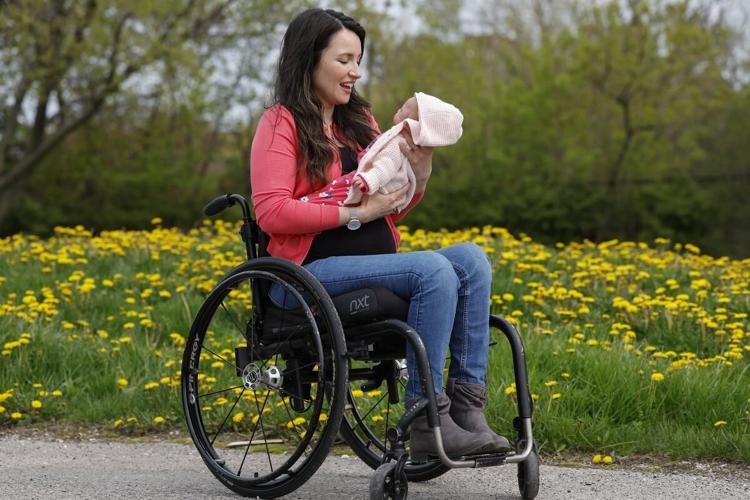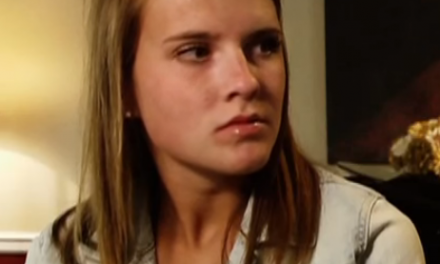The following video was filmed one year after the shooting which caused Danielle to become paralyzed. The article below from the Toronto Star is an update from May 2023 with some exciting news and changes to her life. It is important that you view both to better get an understanding of how her life has proceeded since the shooting attack.
On the night Danielle Kane was shot, she lost her mobility, her career as a nurse and her dreams of having a family.
Sunshine spills into Danielle Kane’s living room.
Sitting in its dappled light, she wheels around to look out the large windows, taking in the view of her Scarborough neighbourhood.
From the 26th floor, she can see the nearby library, the ribbons of trees newly green with spring leaves, the mall she used to wander with friends during her school years.
Though she’s only lived in this condo since December, Kane says moving in felt like coming home.
Just a few years ago, all of this — her light-filled living room, her new husband, the promise of their life together — seemed far out of reach.
Kane, now 36, was among the 13 people wounded during the 2018 Danforth shooting rampage that killed two people and left a city reeling in its aftermath.
The bullet that tore through her abdomen and shattered one of her vertebrae also damaged her spinal cord, paralyzing her from the waist down.
Determined to recover, Kane persevered through the months of rehab and years of chronic pain. But when her long-term relationship ended right before the pandemic, Kane spiralled into a deeper depression.
Overwhelmed by the isolation and fighting a growing sense of despair, she says she was mourning all that had been taken from her on the night she was shot: her mobility, her future career as a nurse, her dreams of having a family and being a mom.
“It felt like parts of my life were over,” Kane says.
The evening of July 22, 2018, was warm and still, a perfect night to dine outside on the Danforth, where Kane and her then-partner were celebrating a friend’s birthday at 7Numbers, a busy Greektown restaurant.
Kane was finishing her dinner on the streetfront patio when she heard the pop-pop-pop.
Within moments, a server was rushing diners inside the restaurant, warning them that someone nearby was firing a gun.
In the days to come, a fuller picture would emerge of how a shooter walked 400 metres down Danforth Avenue, spraying bullets seemingly at random, first into a parkette, then into restaurants and cafes, injuring 13 people and killing Reese Fallon, 18, and Julianna Kozis, 10. The shooter, who would be identified as 29-year-old Fasail Hussain, would kill himself during a gunfight with police. The gunman had no affiliation with any radical ideology or terrorist organizations, but was a “troubled individual” with an extensive history of mental health issues, investigators later concluded.
Inside the restaurant, Kane didn’t know what was happening. But she and her partner rushed out when they heard someone may have been injured.
Kane, who had just completed her first year of nursing studies and was an administrative assistant at Michael Garron Hospital, and her partner, an ER nurse at the hospital, felt compelled to help.
“When there’s trouble, you go toward the trouble,” she recalls about the decision to go outside. “I thought, if there’s injured people we need to intervene because sometimes those first few minutes are so crucial.”
When Kane opened the door, she saw the gunman. Almost immediately, he fired in their direction. One bullet hit Kane and she fell to the ground, the impact breaking her ribs.
Her partner pulled her back inside the restaurant and stayed until an ambulance could take her to St. Michael’s Hospital.
Lying on the floor, her lungs filling with blood making it harder and harder to breathe, Kane remembers thinking she could be paralyzed.
“I couldn’t feel my legs,” she recalls. “And the longer I lay there, the more I worried I was dying. I kept thinking, no, I don’t want my last memories to be bleeding out on this restaurant floor, this is not how I envisioned my life would end.”
Kane spent 11 days in a medically induced coma, intubated and on a ventilator.
The bullet had shattered her T11 vertebra, one of the thoracic vertebrae lower down on her spine. Surgeons stabilized her spine by fusing two of the nearby vertebrae. Another surgical team, during three operations, repaired the extensive injuries to her abdomen.
Her mother, Joy, remembers being at her bedside, praying she would open her eyes.
“We didn’t know how bad the injuries were going to be. We were just hoping she would survive.”
Once Kane had recovered from the surgeries, she spent two months at the Toronto Rehabilitation Institute, where staff helped her work through intensive physiotherapy, find ways to manage her pain and get her accustomed to her wheelchair.
Then she went home, hoping she and her partner could get past the trauma and get on with their lives.
Few relationships can withstand a traumatic event. This is what Kane says when asked why the long-term relationship ended in early 2020, after more than three years together.
“A spinal cord injury, it’s just not something people plan for,” she says. “I hold nothing against him that things didn’t work out between us.”
Two months after their split, the pandemic hit.
Alone in her Oshawa home, Kane struggled to care for herself and still couldn’t treat the burning chronic pain that made the lower half of her body sting with intense pins and needles.
As the months wore on, and as she felt ever more isolated, Kane says she slid deeper into a depression.
She recalls with clarity the day that things changed.
Feeling overwhelmed, Kane says she called out to God for help, pleading for relief from the isolation and loneliness, though at the time she considered herself an atheist.
Looking back, Kane says she can’t explain why she turned to God. After she was shot, friends and family had prayed for her wellbeing. It had not brought her comfort until that moment.
“I was at the end of myself. I was very desperate and entertaining thoughts of self-harm. I said: ‘God, if you are real, I really need you right now because I can’t do this on my own.’
“All I can say is that I felt this feeling of peace, and the anger and bitterness I had from struggling so much in my situation just went away. I can’t really explain it except that I felt like God was here to help me.”
Since then, Kane says her faith has become a source of strength and hope, buoying her on hard days. She says it helped her cope with the unrelenting pain that was slowing her recovery and that, in the months following her plea, she was able to reduce some of her medications.
Kane says it was also the start of a new chapter in her life.
Toward the end of the second pandemic year, Kane cautiously began to think about opening herself up to a new relationship.
One of her mentors in the spinal-cord injury community suggested online dating, reminding her she was still a young woman and didn’t need to close off this element of her life.
She created a dating profile using only three photos, each clearly showing her wheelchair, and wrote that she used the wheelchair because she was shot, listed books important to her and stated she wanted to find someone who was serious about their Christian faith.
“And it’s crazy. I met the most perfect person for me.”
During the months they dated, the couple found themselves spending more and more time together, often at each other’s homes eating meals, watching TV and talking about life’s challenges and their faith. It didn’t take long to realize they wanted to build a life together.
They got engaged in March 2022 and were married four months later at their large Toronto church.
The night before her wedding, knowing this would be a special moment for her and the 300 guests attending the reception, Kane practised dancing in her wheelchair, her mom overseeing the choreography. Kane had once loved to dance, often the first on the floor and the last to leave, and she says she wanted to feel that way at her own wedding.
For the first dance, the DJ put on Celine Dion’s “The Power of Love” and Kane wheeled to the centre of the dance floor.
As her husband slowly spun Kane, her chair gliding around in a small circle, their guests rushed forward to take their picture. Kane, wearing a long white gown, smiled up at her husband. The yellow flower pinned to his tuxedo’s lapel matched the bouquet of yellow, peach and dark red roses placed on her lap.
“Everyone was in tears,” recalls Joy. “There wasn’t a dry eye in the room.”
Kane had always wanted to be a mom.
After she had recovered from her shooting injuries, Kane was told pregnancy was possible. But at that time, with so much chronic pain, having a baby seemed a far-off hope. And when she found herself alone during the pandemic, Kane thought her chance at motherhood was gone.
“I was struggling with the reality of my injury and my situation, and believing my dream of being a wife and a mom wouldn’t happen.”
With her new husband, she started to dream again. They both wanted to be parents, though Kane worried that at 36 and with a spinal cord injury it wouldn’t be easy and may be impossible.
Feeling tired and nauseous she took a pregnancy test a few days after returning from their August honeymoon in Quebec.
“I called my mom to tell her right away,” Kane says.
Says Joy, with a laugh: “Before I could even say ‘Hello,’ she was telling me the news.”
Though anxious about a safe pregnancy, Kane says she put her trust in God. Since finding her faith during COVID, Kane says she believes God is helping her.
“Now,” she says, “I’m always hoping for the best instead of expecting the opposite.”
During her move to Scarborough, Kane struggled to find a family doctor in the area who could refer her to an obstetrician. At 16 weeks she saw Dr. Anne Berndl, a maternal-fetal medicine specialist at Sunnybrook Health Sciences Centre and director of its Accessible Care Pregnancy Clinic.
The clinic, which opened in 2017 and is the first of its kind in North America, provides pregnancy and birth care to people with physical disabilities, including those with spina bifida, cerebral palsy and spinal cord injuries.
Berndl remembers meeting Kane last November. Four months into her pregnancy, Berndl didn’t see any immediate concerns during the initial consultation though they talked about potential risks.
“She was so full of hope. It became a joy to take care of her.”
People with spinal cord injuries face higher risks during pregnancy, including bladder and kidney infections, and going into preterm labour. They also have a higher chance of being diagnosed with intrauterine growth restriction, meaning a fetus does not grow as expected and the baby is born smaller than anticipated for its gestational age.
Berndl monitored Kane closely and assembled a team including urologists, anesthesiologists and neonatologists, who created a unique pregnancy and delivery plan.
Beyond the high-risk pregnancy itself, the main concerns were the scar tissue in Kane’s abdomen, the result of the surgeries for her shooting injuries, and whether her delivery would harm her bladder, which had been surgically altered a few years earlier.
Like many people with spinal cord injuries, Kane needs to use a catheter to empty her bladder. In 2021, Kane had surgery to enlarge her bladder and make it more stable.
Her surgeon, Dr. Sender Herschorn, a urologist at Sunnybrook and professor of surgery at the University of Toronto, also created a continent catheterizable channel, or CCC, to allow urine to empty through a stoma in her abdomen.
Prior to the procedure, Kane could only empty her bladder while lying down, making it difficult to spend more than three or four hours away from home.She calls the surgery “liberating,” a milestone in her recovery.
As her pregnancy progressed, Kane and the Sunnybrook team decided a planned C-section would be the safest way to deliver her baby.
While people with spinal cord injuries can have vaginal deliveries, Berndl says they can’t always feel the sensation of contractions.
“So you’re in this scenario where someone is at an increased risk of preterm labour but is also not being as able to perceive it.”
A scheduled C-section allowed for more planning, and for Kane’s key team members to be in the operating room, including Herschorn. He would carefully separate scar tissue from her bowel and abdominal wall, allowing access to the uterus.
Together, the team decided on the safest place to make the incision. It would be a vertical cut in the centre of her abdomen, stretching from the bottom of her rib cage to her belly button, rather than the typical half-moon incision made lower down near the pubic bone.
Berndl gave Kane and her husband a photo that mapped out the proposed incision on her abdomen.
“We had it saved on our phones,” says Kane, “just in case I delivered unexpectedly and my team couldn’t be there.”
Kane was admitted to Sunnybrook one week before her scheduled delivery date of April 4. She was 36 weeks pregnant and Berndl and the team wanted to keep a close eye on Kane and her baby.
During her pregnancy, Kane had been in and out of hospital, including a nearly weeklong stay in February at 27 weeks when Berndl became worried about preterm labour. The team was happy when Kane safely made it to 37 weeks.
On the morning of April 4, Kane was wheeled to a main operating room. The 20-person team was in place, including specialists from the neonatal intensive care unit.
Before going into the OR, Kane prayed with her mother and husband. Then Joy kissed her daughter and said, “I love you.”
For much of Kane’s pregnancy, the anesthesiologists involved in her delivery planned to use a general anesthesia. But days before, they came up with a way to keep her awake.
Kane couldn’t have a standard epidural; it wouldn’t be able to go high enough to accommodate her unconventional incision. Instead, Berndl says the anesthesiology team used two types of pain control: a thoracic epidural that was inserted towards the ribcage portion of her spine as well as a second dose of anesthetic in her lower spine.
“She had lots of pain control available to her and she was actually able to be awake for the whole thing.”
The delivery took about 15 minutes. Herschorn, who stood across from Berndl during the birth, each on either side of Kane’s belly, was able to quickly dissect through the scar tissue on the bowel to reveal the uterus. Minutes later, Berndl delivered Kane’s baby, who was breech, toes first.
Berndl says she’ll never forget the sound of Kane’s voice when she saw her baby daughter for the first time.
“There was this sense of, ‘Here she is, we’ve made it!’ It was such a joyful exclamation.”

She came home after four days with Chloé, born at five pounds, four ounces.
Chloé is now five-and-a-half weeks old, and Kane says the days are often still a blur, even with Joy, on a short leave from her neonatal nursing job, staying for a few weeks to help.
With her C-section scar healing, Kane is regaining strength in her upper body and is again able to move around her home with ease.
Before they moved in, the couple replaced the carpet with smooth, laminate floors and Kane’s husband modified much of the furniture, including raising their couch and living room chairs so Kane can easily transfer herself from her wheelchair.
When she needs to reach Chloé, Kane wheels right up to the edge of the bassinette to lift her out. Her brother-in-law modified its base, clearing space for her wheelchair, and there are similar plans for a crib when Chloé gets older.
Today, Chloé — her middle name chosen for her two grandmothers, both named Jocelyn — sleeps under a purple, hand-crocheted blanket that Kane received while recovering from being shot. Though she never used it, Kane kept it as a reminder of how kind people were during that time.
After Chloé softly cries out, Kane’s husband brings her their daughter. Kane uses a large nursing pillow set on her lap to help her hold Chloé, who is soon nestled in the crook of her left arm.
These are the moments Kane holds on to, the ones that make her reflect on how far she has come since the violent attack that altered her life.
Like she did in the weeks and months following the rampage, Kane says she plans to take this early time with Chloé day by day. She knows there will be challenges, but says she is determined to focus on light and hope.
For now, Kane wishes for what she calls small joys with her new family. Taking Chloé to their church for the first time. Picnics. Going to Woodbine Beach, Kane’s favourite stretch of Lake Ontario.
With Chloé starting to squirm in her arms, Kane shifts her slightly to a different position. She cradles her small head in her hands, then smooths back wisps of her fine hair.
“Hi,” she says with a wide smile as Chloé opens her eyes. “You’re awake. It’s nice to see you.”
Article originally appeared in the Toronto Star
Video From CBC




